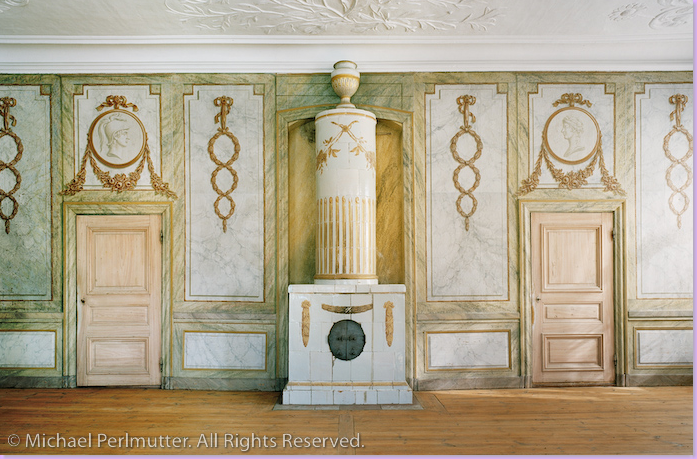(Linky at the bottom.)
Well, I didn't do a single bit of quilting work this week, but I did use some quilter's tools in the remodel work I put in. I also found it entertaining when I was describing to my father what I wanted done with our fireplace facade, and that two contractors told me flat out that it's impossible, and his response was, "Hahaha! They're talking to a master quilter. Of course you can find a way to do it!"
Well, since not one of the 5 craftsmen who came to survey the job and offer estimates would take the job on, it's mine.
This is what I started with on Friday. We want a pretty marble-and-glass mosaic tile installed floor to ceiling, around all the edges of the sidewalls and the inset, with the tile bits intertwined at the corners. Having started into the job, I can see why none of the craftsmen wanted to do it (although I would have paid them for the time involved).
You can't approach it from a normal tile installation stand point. Basically, it's an art project that will require a lot of finicky work "brick" by "brick" at the corners. And it can be super tricky cutting this type of mosaic tile if you're looking for standard speed-working techniques.
For now I'm only concerned with getting the top half put up so that we can install the rest of the crown molding in the room and free Scott's saw up for the other work he needs to do.
By last night I had the inner surface installed.
(You can see the jagged sides that I left open for upcoming corner work.)
It's so PRETTY!!!! And oh-my-gosh! When I woke up, the morning light coming in through the east-facing bay windows made it sparkle in the most amazing way!! I will unexpectedly have a gorgeous ice-castle style hearth wall over there when we're all finished!
There's not a whole lot of technical information out there for how to do what I want to happen on this complicated fireplace wall, so please forgive all the strategy details I'll be sharing that have nothing to do with our normal quilting interactions.
First of all, these walls were painted in latex eggshell - quite a slick surface. So I gave the fireplace corner a good, solid sanding with 80 grit paper, then damp-wiped it down very well.
The surface of these tiles is super uneven, and I did *not* want to deal with that at the paint edge when it's time to finish the mantle.
So I used spacers on the bottom, and will put in a line of caulk there to give a straight bead line at painting time.
(This tile is designed to be installed without grout.)
Because my autoimmune issues greatly limit the amount of time I can work on anything requiring muscle work, as well as exposure to fumes, I'm using a premixed mastic instead of real thinset/mortar. It's working very well. I can put an hour in here and there and not lose a lot of time and product mixing a set of thinset up each time I do some tiling.
Also, since I'll have exposed edges over a period of probably two or three weeks, I'm not trowling the mastic onto the wall, but onto the back of the tiles. That's a pain, but is turning out quite apropos. [When I do get to the bottom half of the fireplace wall, I will be filling the holes and floating that torn-up area with true thinset before starting the tile work.]
Because of the marble tile pieces, I needed to make sure I used the white option.
For educational purposes, this^ stuff that I'm using is not technically thinset mortar, even though it's marketed that way. It's mastic. It's completely different chemically, and often behaviorally, from true thinset mortar, which you will *always* have to buy as powder and mix with water. This stuff is good for the job I'm doing, but would not be good for a location where it will be wet often. You want real thinset for that.
Today I got the that top inside edge tiled, with two helpers on hand to hold the previous piece up while I worked on the next mosaic piece. (There are 30 rows of tiny bricks in each 12 x 12 mosaic tile, and this area is just under 3 tiles wide.)
Then we braced it with the board Scott cut for me.
I had topped the board with a double layer of wool batting scraps and some waxed paper. The batting has a dual purpose: protect the marble pieces from direct pressure of the plywood, and allow pressure to reach all the bricks instead of only the thickest ones.
That bottom board is there to keep the bracers from marring the oak mantle board. It's only primed so far, so minor scratches don't matter, but we don't want any actual dents. I can't wait to get its finishing trim work added on!
The waxed paper is there to keep the batting from catching on all the unpolished marble edges, and hopefully releasing easily from any bits of oozed-through mastic I might have missed before we put the board up.

You can see here how Scott added bracer-stops on either end of the support board, so that the bracers wouldn't slip when we hammered the bottom ends nice and taut into their positions.
I'll leave all that in place for a couple days to let the mastic completely set up behind the upside-down tiles. If I were using thinset, I could release it a lot sooner.
[Thinset gets hard as it chemically reacts with water molecules, breaking those apart and forming new compounds as it hardens - and it does this fairly quickly. Mastic gets hard as the water evaporates out of the product and allows it to set itself up.]
That's OK. This batch of work has done a number on my muscles, so it's good to focus on other work while I wait to move the boards out of the way to start on those side edges and the corners involved there.
~*~*~
So, hey! While I was working on doors and frames and hardware and curtains and tiling this week, did you manage to get some quilting BOM work done?
and linking up from either end puts you on the party at both sides.














































